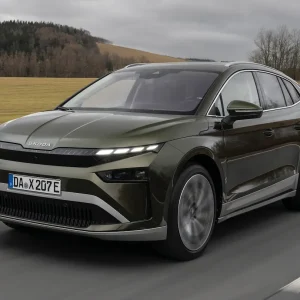The Ford Focus is the Blue Oval’s top selling car globally and is one of the most successful fleet cars in the UK so radical change for this facelift is not on the cards.
Ford has, however, made some key improvements in lots of different little areas following feedback from customers.
To Ford’s credit, the new model stands out quite significantly in its looks in comparison to the previous model. The front end now has the clamshell bonnet and Aston Martin-like grille sported by the Fiesta, which instantly indicates it as the latest model.
Ford said it has worked hard tweaking areas of the car specifically to help improve its residual value performance and according to Kwikcarcost, the 1.5-litre Ecoboost Titanium we drove actually just surpasses the Volkswagen Golf 1.4 TSI Bluemotion Tech in terms of its RV, at 33.8% and 33.7% respectively.
The trim line-up remains largely unchanged with six to choose from. The Studio keeps the same entry-level price as the previous model at £13,995 and then there’s Style which replaces Edge, then Zetec, Zetec S, Titanium and Titanium X. The Zetec to Titanium models make up for 90% of all UK Focus sales. There is still a fleet bias to Focus sales, with a 55% split going to corporate buyers.
The trend throughout the industry for downsizing continues, with the 1.6-litre petrol and diesel engines replaced in the Focus range by more efficient 1.5-litre Ecoboost and 120hp 1.5-litre TDCi powertrains.
It’s the 1.5-litre diesel which will take the majority of fleet sales and will be available in two power options, a 90hp and a 120hp, both emitting the same level of CO2 at 98g/km and efficiency at 74.3mpg. The choice then comes down to trims and the P11D price, as the higher-powered diesel is only available on the more expensive Zetec and above.
There will also be a 2.0-litre diesel available and all diesels in the Focus range come with a NOX trapper which means fleets will not need to use AdBlue in order for their car to be Euro 6 compliant.
Unfortunately Ford did not have the top selling 1.5-litre diesel to test on the first drive. BusinessCar will update its review closer to the UK launch in November.
Fleets can also opt for the 99g/km CO2 1.0-litre petrol, which is unchanged from the previous Focus.
The new 1.5-litre Ecoboost is actually great fun to drive, it’s smooth and offers plenty of power, but at 127g/km it skirts too closely to most fleets’ 130g/km cut off.
The Focus is known for its great steering set up and Ford has tweaked this further since it made the move to EPAS on the previous model. Engineers said they reacted to feedback to make the steering lighter without sacrificing response.
Turning into corners requires minimal effort and despite the lack of manual feedback, the handling itself is impressive with bags of grip.
Part of the facelifted Focus’ impressive residual performance is down to some of the new technology included like Ford’s Sync2 infotainment system. It’s available as a £500 option with sat nav on the lower trims and then £250 as an option on Titanium and Titanium X. Ford argues the residual performance on the Titanium actually cancels out the additional cost.
Ford was keen to push the improved voice control functionality on Sync 2 and it is a vast improvement over the previous model and it might actually be the best example of voice control so far. Rather than having to stick to a small amount of commands which work, the system has been expanded to recognise thousands of phrases and can pick out phone numbers spoken rapidly with accuracy.
One of the biggest improvements on the facelifted model is the decluttered dash and centre console. The infuriatingly unintuitive mess of buttons from the previous model have been replaced by a larger eight-inch touch screen separated into four key areas of functionality, media, satellite navigation, phone and climate control. All four can be controlled easily with the voice function, but Ford has made sure any function is only ever two button presses away. It’s also a non-capacitative screen, which means it will still work if you’re wearing gloves in winter.
Like many vehicles in this class, the Focus can be specced with advanced driving assistance options. The park assist functionality can now do reverse bay parking and there’s also a cross traffic system which warns drivers before reversing out of a parking space into an oncoming car.
Ford’s Mykey technology is standard across the range and lets drivers programme a key to limit speed, audio volume and access to drive at certain times. Active city stop is also available to help stop shunts in low speed traffic up to 31mph (up from 19mph).
| P11D price | £20,990 | ||||||
| Residual value | 33.8% | ||||||
| Depreciation | £13,890 | ||||||
| Fuel | £6,835 | ||||||
| Service, maintenance and repair | £1914 | ||||||
| Vehicle excise duty | £220 | ||||||
| National insurance | £1738 | ||||||
| Cost per mile | 50.1p | ||||||
| Fuel consumption | 51.4mpg | ||||||
| CO2 (tax) | 127g/km | ||||||
| BIK 20/40% per month | £63/£126 | ||||||
| Service interval | 12,500 miles | ||||||
| Warranty | 3yrs/60,000 miles | ||||||
| Boot space (min/max) | 316/1215 | ||||||
| Engine size/power | 1496cc/150hp | ||||||
| Top speed/0-62mph | 130mph/8.9secs | ||||||





